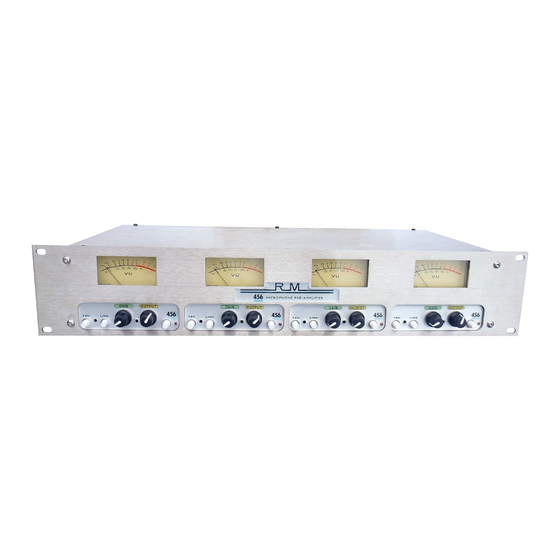
Advertisement
Quick Links
456 Microphone Pre-Amplifier
Features:
•
Golden Era Analogue Microphone Pre-Amplifier Design
•
456HD® Analogue Tape Simulation
•
Discrete Ultra Low Noise Class A Design
•
Ultra Wide Bandwidth
•
Transformer Fully Balanced Inputs and Outputs
•
22 way stepped Microphone Gain Control
•
22 way stepped Output Gain Control
•
Line Input Switch with Output Gain Adjust
•
180º Phase Reversal Switch
•
Accurate Wide Band VU with Calibration Adjustment
•
456HD® Output Level Adjustment
•
Gold Plated XLR Connectors
•
Triple Shielded 6 layer PC Card construction
•
Ultra low noise 48V Phantom Supply
•
2-Channel version available upgradable to 4-Channel
Introduction:
Roger Mayer is proud to announce the latest evolution from a long series of award winning
pre-amplifier designs. It began its development history in 1968 whilst I was working in
Olympic Studios, London. The development continued with my move to New York and the
formation of Roger Mayer Electronics Inc with designs of Recording Studio Desks, RM58
Limiters, RM 68 Noise Gates, Mastering Equalisers and Location Recorders all using
evolutions of our design. These products were supplied to many top Studios in the USA
and Europe. The transparency and detail from our wideband design configuration is
considered by many to be the ultimate 3D sounding pre-amplifier and can be heard on
many landmark recordings of all kinds of musical genres. The phase accuracy and lack of
time smearing artefacts is unbeatable and we welcome audio comparison to other
products. The innovative addition of being able to add the acclaimed 456HD® Analogue
Tape Simulation provides a full analogue signal path from Microphone straight into the
DAW. The result is a Golden Era Signal path for the digital world.
Advertisement

Summary of Contents for ROGER MAYER 456
- Page 1 2-Channel version available upgradable to 4-Channel Introduction: Roger Mayer is proud to announce the latest evolution from a long series of award winning pre-amplifier designs. It began its development history in 1968 whilst I was working in Olympic Studios, London. The development continued with my move to New York and the...
- Page 2 History: The development of Microphone Pre-Amplifiers that were used in recording consoles before 1970 all used discrete configurations that in many ways were derived from the tube circuits previously used. In fact the introduction of silicon low noise transistors did not begin until around 1968.
- Page 3 CHANNEL TECHNICAL INFORMATION: The following details apply for every channel of the 456 and the 2 Channel model can easily be upgraded to the 4 Channel model. Each channel has its own multistage onboard power supply circuits providing the required voltages and also providing signal isolation from the other channels to minimise crosstalk.
- Page 4 MICROPHONE PRE-AMP This is a 2 stage design using both PNP and NPN low noise transistors in our proprietary configuration. The GAIN is controlled by a 22way stepped conductive plastic potentiometer so as not to cause any clicks or drop outs but also have recall ability. GAIN CONTROL is used in conjunction with OUTPUT CONTROL...
- Page 5 MICROPHONE RECORDING OPERATION: So once the 456® Level has been adjusted for your system and you are monitoring in VU Mode 1 (Default), simply plug in your choice of Microphone set the OUTPUT CONTROL to 12 o’clock and adjust the GAIN control so that a reading around 0 VU is obtained.
- Page 6 So as they say give it a listen. The 456 circuit used in the 456 Microphone pre-amplifier is exactly the same as in our other models but does not have the equaliser section so it is perfect for recording with the minimum of fuss during setup.
-
Page 7: Technical Specification
TECHNICAL SPECIFICATION The audio signal path is completely Class A with a very high bandwidth. The -3dB point has been set to above 100Khz. The low end extends to below 10Hz. Peaks are accurately high speed manipulated with ease and maintain the original phase position in the waveform.
Need help?
Do you have a question about the 456 and is the answer not in the manual?
Questions and answers